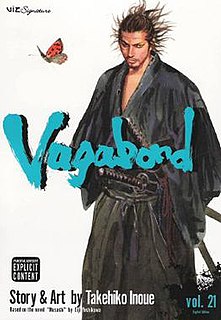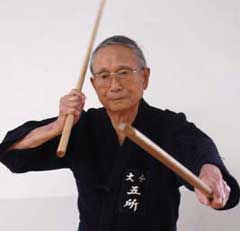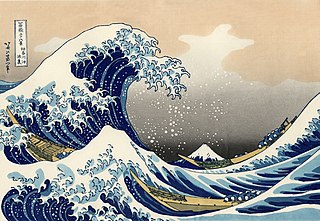
Vagabond is a Japanese manga series written and illustrated by Takehiko Inoue. It portrays a fictionalized account of the life of Japanese swordsman Miyamoto Musashi, based on Eiji Yoshikawa's novel Musashi.
Sasaki Kojirō, often anglicised to Kojirō Sasaki, was a prominent Japanese swordsman widely considered a master of his craft, born in Fukui Prefecture. He lived during the Azuchi–Momoyama and early Edo periods and is most remembered for his death while battling Miyamoto Musashi in 1612.
Takuan Sōhō was a major figure in the Rinzai school of Zen Buddhism.
Niten Ichi-ryū (二天一流), which can be loosely translated as "the school of the strategy of two heavens as one", is a koryū, transmitting a style of classical Japanese swordsmanship conceived by the warrior Miyamoto Musashi. Hyōhō Niten Ichi-ryū is mainly known for the two-sword—katana and wakizashi—kenjutsu techniques Musashi called Niten Ichi or Nitō Ichi.

Musō Gonnosuke Katsuyoshi (夢想權之助勝吉) was a samurai of the early 17th century and the traditional founder of the Koryu school of jojutsu known as Shintō Musō-ryū (神道夢想流/神道無想流). He is perhaps most famous for his duels with the legendary swordsman Miyamoto Musashi.
This is a list of fictional depictions of Miyamoto Musashi, the famous 17th-century Japanese swordsman.
Itō Ittōsai Kagehisa was a famous yet mysterious Japanese swordsman rumored never to have lost a duel. He is attributed as the founder of the Ittō-ryū school of sword fighting.
Takada Matabei was a retainer under the current lord over the Ogasawara during the Edo period of Japan. Matabei was renowned as a famous adept of the art of the lance. While the famous swordsman Miyamoto Musashi had currently been staying within Kokura, Matabei had visited him at many times as to receive his unique teachings. The lord of Ogasawara had at one time requested Matabei to duel Musashi. Matabei was compelled to fight even though he had not wanted to, as to obey his lord's command. Matabei chose to use a bamboo lance, while Musashi chose an ordinary sword made of wood. At the beginning of their duel, Matabei had at first attacked Musashi with his lance, in which Musashi had then calmly penetrated in close range using the middle-level guard and won two times. Matabei's lance had slid between Musashi's legs the third bout however. Due to this fact, Musashi said, "I was touched, therefore I lost this time". Musashi had then told all of the onlookers how much of an adept Matabei was with the lance. Matabei had later said after the duel, "Master Musashi is a true adept whom I was unable to touch. It was to save my face that he acted as though I had won once out of three times".

Matsui Okinaga also known as Nagaoka Sado was a Japanese samurai who served the Hosokawa clan, during the early Edo period. It was Nagaoka Sado himself who had protected Miyamoto Musashi as for him to be able to duel against the famous Sasaki Kojirō in 1612. At one time on the battlefield during the year of 1638, Musashi had met Sado. Sado had known at the time that Musashi was living in the house of Ogasawara, but he had learned that it was Musashi's son, Miyamoto Iori who had been under the service of the Ogasawara, and that Musashi was there as a guest. Sado had also learned that Musashi had no true intention of entering under the lord's service, and that he was only taking part in that battle as a staff in order to be an advisor to his son. After Sado had then returned to the province of Higo, he began planning the steps to get Musashi into the service of his fief, since he had already known that Lord Hosokawa Tadatoshi was interested in him. However, Tadatoshi had been previously schooled in the wisdom of the feudal system, in which he ordered for Musashi to act prudently, because Musashi's current situation as he had known, was residing within the house of Ogasawara, in relation to the fact that it would be a major mistake to show discourtesy.
Miyamoto Mikinosuke a retainer of the Japanese clan of Honda during the Edo period of Japan. Mikinosuke was famous for being the first of three adopted sons of the famous swordsman Miyamoto Musashi. One day Miyamoto Musashi had been traveling on horseback along the Settsu road. At a certain inn at Nishinomiya, Musashi had seen a boy of fourteen or fifteen who had taken Musashi's horse for him. Musashi had perceived extraordinary qualities from this boy—Mikinosuke. Musashi then asked the boy, "Wouldn't you like to become my son? I would find a good lord for you.". Mikinosuke replied, "You are very kind to make such an offer, but I have old parents. The reason I am working as a hostler is to take care of them. If I became your adoptive son, my parents would immediately fall on hard times. I must therefore tell you no, with my thanks.". Musashi had then gone to Mikinosuke's house and met his parents. Musashi then had explained his plans to them, receiving their consent to adopt him. He then took Mikonosuke with him after giving a small sum or supportive money to his parents.
Iba Hideaki was a famed swordsman during the Edo period of Japan. Hideaki had been an adept of the Shinkage-ryū at an early age, but later concluded to himself that the school had not reflected realistic fundamentals, which is why he then chose to travel around and look for a school that would better fit him. Hideaki had then followed in a certain duel with an unknown swordsman skilled within the Enmei-ryū in the Kyūshū region. Hideaki had lost the duel, in which he chose to become a disciple under the man that had defeated him. Years later, Hideaki would change his name to Iba Zesuiken, in which Hideaki founded the Shingyōtō-ryū school of swordsmanship in 1682, which was basically a merging of the Shinkage and Enmei's way of the sword. The name of Hideaki's school had meant "School of the Sword That Shapes the Mind". What Hideaki had truly meant by having such a name was the fact that within the time of combat, one will be amongst two states of mind—that of attacking the opponent or fleeing out of fear. Through this, Hideaki employed the principle that one should always attempt to deepen their level of technical accomplishment in order to create within themselves an unshakable form.
Terao Magonojō was a famed swordsman during the Edo period of Japan. Magonojo was the elder brother of Terao Motomenosuke, the successor to the School of Musashi. Magonojo had been noted as Miyamoto Musashi's favorite student, to whom Musashi entrusted his Gorin no sho before his death. Throughout Magonojo's earlier years, he had trained with the kodachi with Musashi throughout many times. At one time when they were both training, Musashi had attacked Magonojo with a large wooden sword, in which Terao then parried with his short wooden sword and had counterattacked. After several repetitions of this action, Terao's sword had unfortunately broke while Musashi was in the middle of striking his sword downward from above. However, Musashi's sword had stopped just minutely from hitting the skin of Terao's forehead. Thus, Magonojo had received no injury. This degree of control had reflected well on Musashi's skills. Before the death of Magonojo's master, he had assumed the role of successor. It is thought that Magonojo had burned the original Gorin no sho through Musashi's orders because the complete original version cannot be found.
Furuhashi Sōzaemon was a Japanese samurai of the early Edo period. Famed for his skill in swordsmanship. Sōzaemon, along with both Terao Magonojo, and his younger brother Terao Motomenosuke would be the legendary Miyamoto Musashi's three chosen successors. After their master's death, Sōzaemon had borrowed Magonojo's Gorin no sho for a few days, in which he made a copy of this book and gave it to Lord Hosokawa Mitsuhisa through his orders. Furuhashi himself would also make another copy of the book which was later transmitted to his disciples, which went by the name of Ihon gorin no sho. The following copy ends with this notice:
Tsutsumi Hōzan (堤宝山), also known as Tsutsumi Yamashiro no kami Hōzan (堤山城守宝山), was a swordsman during the Sengoku period of Japan, who founded Hōzan ryū.

Samurai Reincarnation is a 1981 Japanese fantasy film written and directed by Kinji Fukasaku and starring Sonny Chiba, Kenji Sawada, and Hiroyuki Sanada. It is based on the novel of the same name by Futaro Yamada.
Yoshioka-ryū (吉岡流) is a koryū Japanese sword-fighting martial art and is part of the Kyohachi-ryū. The Yoshioka-ryū became famous during the latter half of the 16th century when Yoshioka Kenpo was assigned to be the sword instructor of the Ashikaga shōguns in Kyoto.

The Gosho Ha Hyōhō Niten Ichi-ryū (五所派兵法二天一流) was one of the branches of the Niten Ichi-ryū, the Kenjutsu school created by Miyamoto Musashi, under the supervision of Gosho Motoharu, Shihan of the 9th generation. Since April 2007 was reintegrated with the seito under Yoshimoti Kiyoshi, 12th successor of Hyōhō Niten Ichi-ryū and 10th successor of Gosho-ha Hyōhō Niten Ichi-ryū.
Shinmen Munisai, also called Miyamoto Muninosuke, was a martial artist, expert in using the sword and the jutte. He was also the father of the samurai named Miyamoto Musashi. He was the son of Miyamoto Musashi no kami Yoshimoto, a vassal of Shinmen Iga no Kami, the lord of Takayama Castle in the Yoshino district of Mimasaka Province. Munisai was relied upon by Lord Shinmen Sokan,the head of the Shinmen clan and so was allowed to use the Shinmen name. He was one of the few to have obtained the title of "Unrivaled Under The Sun", title offered to him by the Shōgun Ashikaga.






